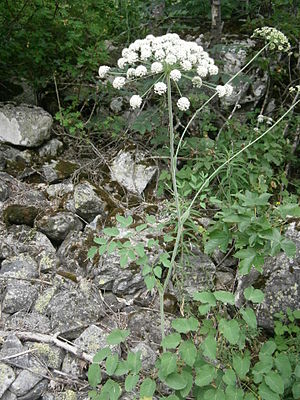Broad-leaved laser herb
| Broad-leaved laser herb | ||||||||||||
|---|---|---|---|---|---|---|---|---|---|---|---|---|

Broad-leaved laser herb ( Laserpitium latifolium ) |
||||||||||||
| Systematics | ||||||||||||
|
||||||||||||
| Scientific name | ||||||||||||
| Laserpitium latifolium | ||||||||||||
| L. |
The broad-leaved laser herb ( Laserpitium latifolium ) is a plant in the umbelliferae family (Apiaceae). It occurs mainly in the Alps .
description
Vegetative characteristics
The broad-leaved laser herb grows as a perennial herbaceous plant that reaches heights of 50 to 150 centimeters. All parts of the plant are bare and often a little bluish. The bare stem is branched and only slightly grooved.
The broad-leaved laser herb can be distinguished from the other types of laser herb by the shape of its leaves. The leaf blade is two to three pinnate. The leaflets are broadly ovate with a weakly heart-shaped base; in other species the leaflets are undivided and sawed on the edge.
Generative characteristics
The flowering period extends from July to August. There is a double-ended inflorescence . The umbel of the first order has a diameter of 10 to 15 centimeters and narrow triangular bracts . The husk-leaves of the döldchen are narrow sub-sub-like. In addition to hermaphrodite flowers, there are also purely male flowers; So it is Andromonözie .
The split fruit is a double achane . With a length of 7 to 10 mm and a diameter of 4 to 6 millimeters, the winged partial fruits are relatively large and about 8 mg in weight. The fruits ripen between September and October.
The number of chromosomes is 2n = 22.
ecology
The broad-leaved laser herb is a hemicryptophyte and a half-rosette plant with a thickened beet .
Biologically speaking, they are “nectar-bearing disc flowers” of the “Heracleum type”. The pollination is done by different insects , especially flies and beetles .
The fruits are wind and animal shakers, they are also transported through rivers and ruminants spread randomly . It is a cold germ .
Occurrence
The main distribution area of the broad-leaved laser herb is in the subalpine altitude of the Alps , especially in limestone areas . In the Allgäu Alps, the broad-leaved laser herb at the southern foot of the Widderstein in Vorarlberg rises to an altitude of 2100 meters. The broad-leaved laser herb thrives mainly in dry forests, on sunny forest edges or on meadows .
It is a character species of the association rabbit- laser herb hem ( Bupleuro longifolii-Laserpitetum latifolii ) in the association of xerothermal hem societies ( Geranion sanguinei ). This montane fringe society stretches in high elevations from the Swabian Alb to the Steigerwald . In addition to the eponymous character species broad-leaved laser herb and long-leaved hare's ear, forest scabious , mountain thistle , blue-green sedge , forest cranesbill , hare lettuce , great beaver and ox-eye determine the image of the association. It also occurs in societies of the order Seslerietalia or the associations Trifolion medii, Calamagrostion or Erico-Pinion.
Subspecies
One can distinguish the following subspecies:
- Laserpitium latifolium L. subsp. latifolium : It occurs in Spain, Andorra, France, Italy, Germany, the Czech Republic, Austria, Liechtenstein, Slovakia, Ukraine, Russia and Belarus.
- Laserpitium latifolium subsp. merinoi P. Monts. : It occurs in Spain.
- Laserpitium latifolium subsp. nevadense Mart.Lirola, Molero Mesa & Blanca : It occurs in Spain.
literature
- Henning Haeupler, Thomas Muer: picture atlas of the fern and flowering plants of Germany . Ed .: Federal Agency for Nature Conservation (= The fern and flowering plants of Germany . Volume 2 ). Eugen Ulmer, Stuttgart (Hohenheim) 2000, ISBN 3-8001-3364-4 .
- Wolfgang Adler, Karl Oswald, Raimund Fischer: Excursion flora of Austria . Ed .: Manfred A. Fischer. Eugen Ulmer, Stuttgart / Vienna 1994, ISBN 3-8001-3461-6 .
- Christian Heitz: School and excursion flora for Switzerland. Taking into account the border areas. Identification book for wild growing vascular plants . Founded by August Binz. 18th completely revised and expanded edition. Schwabe & Co., Basel 1986, ISBN 3-7965-0832-4 .
- Erich Oberdorfer : Plant-sociological excursion flora . With the collaboration of Theo Müller. 6th, revised and expanded edition. Eugen Ulmer, Stuttgart (Hohenheim) 1990, ISBN 3-8001-3454-3 .
- Konrad von Weihe (ed.): Illustrated flora. Germany and neighboring areas. Vascular cryptogams and flowering plants . Founded by August Garcke. 23rd edition. Paul Parey, Berlin / Hamburg 1972, ISBN 3-489-68034-0 .
- Ruprecht Düll , Herfried Kutzelnigg : Pocket dictionary of plants in Germany and neighboring countries. The most common Central European species in portrait . 7th, corrected and enlarged edition. Quelle & Meyer, Wiebelsheim 2011, ISBN 978-3-494-01424-1 .
Individual evidence
- ↑ a b c Erich Oberdorfer : Plant-sociological excursion flora for Germany and neighboring areas . With the collaboration of Angelika Schwabe and Theo Müller. 8th, heavily revised and expanded edition. Eugen Ulmer, Stuttgart (Hohenheim) 2001, ISBN 3-8001-3131-5 , pp. 723 .
- ↑ Erhard Dörr, Wolfgang Lippert : Flora of the Allgäu and its surroundings. Volume 2, IHW, Eching 2004, ISBN 3-930167-61-1 , p. 288.
- ↑ Heinrich E. Weber: Bushes, hedges, herb edges. Ulmer Verlag 2003, ISBN 3-8001-4163-9 , p. 180 f.
- ↑ a b c d R. Hand (2011): Apiaceae. Laserpitium latifolium In: Euro + Med Plantbase - the information resource for Euro-Mediterranean plant diversity. Berlin 2011.
Web links
- Laserpitium latifolium L., broad-leaved laser herb. In: FloraWeb.de.
- Broad-leaved laser herb . In: BiolFlor, the database of biological-ecological characteristics of the flora of Germany.
- Laserpitium latifolium L. In: Info Flora , the national data and information center for Swiss flora . Retrieved January 10, 2016.
- Distribution in the northern hemisphere according to Eric Hultén
- Thomas Meyer: Data sheet with identification key and photos at Flora-de: Flora von Deutschland (old name of the website: Flowers in Swabia ).


